With all paintings, I start with a sketch. Since I will not be transferring the sketch directly to my feather, I keep the sketch loose. I am not familiar with salmon anatomy, so I did quite a bit of research on these fish while sketching. There will also be a fisherman in this painting, so I not only had to research Atlantic Salmon, but also the specifics of fly fishing!

To prepare the feathers (my canvas), I take two turkey tail feathers that look good layered on top of one another. I try to use two feathers that curve in the same direction (both from the right side of the tail, for instance), as this creates a nice layered double feather. To attach the feathers together, I use PVA bookbinding adhesive, which is acid-free and archival. This glue is perfect, as it dries quickly and clear.
Once the glue is completely dry, I spray the feathers with workable fixative. The fixative helps prevent the feather vane from separating, though it is not a perfect hold, and I still need to be careful when painting the first layer. Once the fixative is dry, I paint the first layer. At this point, I simply block in the main colors in watered-down acrylic. This also serves not only as an underpainting, but the acrylic also acts as a 'glue' to lock the barbs of the feather together, preventing it from opening.

At this point, the feather looks extremely sloppy, but at the beginning the main purpose is getting the feather 'locked.' The second step is to fill in the colors a bit more, but not putting in detail yet.

One thing to remember when painting feathers is that the paint seems to dry a bit slower than on canvas or board. I use this to my advantage to blend, particularly in the salmon where I want a smooth blend between the darker top half and the silvery bottom half. Here I start putting in minor details, still blocky, in the fish and background.

Once the main underpainting is done, I start on the detail. When I work with detail, I tend to work fast, as I want to be able to blend while the paint is wet. Unlike oils, which take several days to dry, acrylic dries in a matter of minutes, and although it dries slower on feathers, you still need to work quickly if you want to blend on the feather itself.
Although I have several reference shots of flowing rivers, I don't like to simply paint a scene right from nature. I see the opportunity with the salmon's wonderful curve to move the water around it and compliment both the form of the fish and the shape of the river. I've taken liberties with the water, not focusing so much on pure water physics, but seeking a more aesthetic river.

The next post will contain the second half of progress, as well as the finished feather.

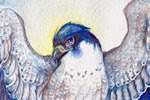
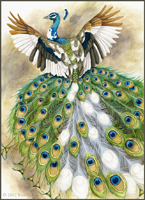
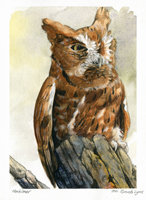
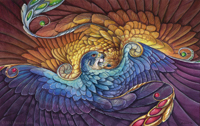
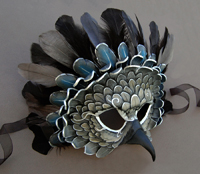
This is beautiful! I also think it's so sad in this day and age of hyper critical little brats that you feel the need to explain your choice in the movement of the water. :P I would not have noticed or cared, it looks lovely!!
ReplyDeleteThank you! And yeah, I've always seen my wildlife art as more of a mixture of natural with a tiny bit of fantasy mixed in. Not 'magic' fantasy, but rather bending naturalism a tiny bit to make things more beautiful. Indeed, I put that note in because I know if I don't, it's very likely someone will try to point out the 'errors'!
ReplyDelete